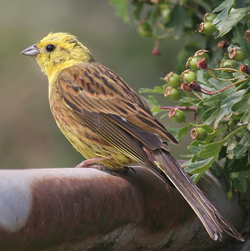Body size changes in passerine birds introduced to New Zealand from the UK
Yellowhammer, by Jill Pakenham.
Blackburn, T.M., Monroe, M.J., Lawson, B., Cassey, P. & Ewen, J.G. (2013)
NeoBiotica 17: 1-18
One feature of global geographic variation in avian body sizes is that they are larger on isolated islands than on continental regions. Therefore, this study aims to assess whether there have been changes in body size following successful establishment for seven passerine bird species (blackbird Turdus merula, song thrush T. philomelos, house sparrow Passer domesticus, chaffinch Fringilla coelebs, greenfinch Chloris chloris, goldfinch Carduelis carduelis, yellowhammer Emberiza citrinella) introduced from the continental islands of the UK to the more isolated oceanic landmass of New Zealand in the middle of the nineteenth century.
Measures of tarsus length were taken from individuals from contemporary UK and New Zealand populations of these species, and from historical specimens collected around the time that individuals were translocated from the UK to New Zealand. Analysis of Variance was used to test for size differences between contemporary UK and New Zealand populations, and between historical UK and contemporary UK and New Zealand populations. Historical UK populations have longer tarsi, on average, than 12 (7 UK and 5 New Zealand) of the 14 contemporary populations. Significant decreases in tarsus length relative to the historical populations have occurred in the UK for blackbird, chaffinch and greenfinch, and in the New Zealand blackbird population. Contemporary New Zealand house sparrows have significantly longer tarsi, on average, than both historical and contemporary UK populations. Exposure to novel environments may be expected to lead to changes in the morphology and other traits of exotic species, but changes have also occurred in the native range. In fact, contrary to expectations, the most common differences we found were between contemporary and historical UK populations. Consideration of contemporary populations alone would underestimate the true scale of morphological change in these species over time, which may be due to phenotypic plasticity or genetic adaptation to environmental changes experienced by all populations in the last 150 years.







Share this page